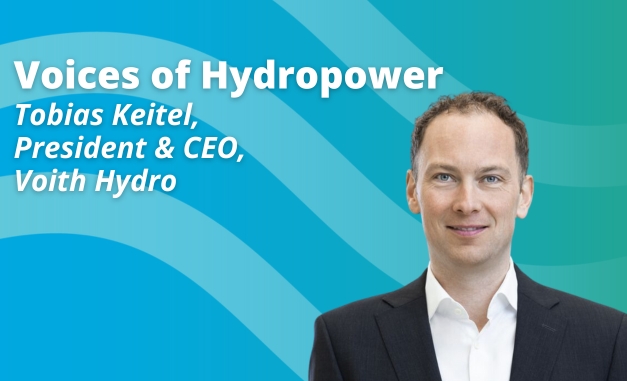The future energy mix: water as energy storage
On Thursday 4 September at World Water Week 2014 in Stockholm, we joined with the Centre for Environmental Design of Renewable Energy (CEDREN) and the United Nations Institute for Integrated Management of Material Fluxes and Resources (UNU-FLORES) to present a seminar on Water as energy storage for better integration of renewables.

You can watch the full recording of the seminar here.
In the first presentation, IHA chief executive Richard Taylor spoke about the role of hydropower in delivering energy services while considering other water needs.
He explained how hydropower can be used “to produce continuous electricity – or ‘base load’ as we call it in the electricity sector – or it might be designed to produce electricity when it is most needed, and be switched off at any other time”.
Richard highlighted a growing need for electricity for power, transport and heating/cooling. “There is an expectation that electric vehicles will become the norm in the road transport sector, as it is already for the railways” he said.
“Also, we are increasingly using electricity to manage the temperature in our homes and workplaces.”
Speaking on the challenges in developing completely renewable systems, he said: “The storage and balancing system is changing. We have gone from a daily, predictable change to one where we have an increasing proportion of variable input from wind and solar, and the timeframes in which we have to match supply and demand are getting tighter and tighter.
“There is a need for more and more advanced equipment to keep the system reliable.”
Atle Harby, director of CEDREN, spoke about how water for energy storage can support the integration of solar and wind power.
If you have a large body of water, you can turn hydropower on and off without having to pump it back. You can just vary your production.” – Atle Harby, CEDREN
He explained that studies by many organisations on future energy scenarios have pointed towards the same conclusions – that for electricity “we need better infrastructure, we need energy storage, we need to improve our demand-side management, and we need to improve our forecasting of resources”.
He highlighted hydropower as the primary provider of energy storage in the world by a significant margin: “In remote areas there are other solutions, but on the grid, hydropower is by far the cheapest.”
Atle also spoke about how hydropower can provide different storage technologies, including both pumped storage and reservoir hydropower: “If you have a large body of water, you can turn hydropower on and off without having to pump it back. You can just vary your production.”
He discussed how Norwegian hydropower could be further developed to act as a battery for renewable energy systems in Europe. “We have looked at whether we could develop more hydropower capacity from existing reservoirs,” he said.
“The conclusion was that 20,000 MW from Norway in additional capacity that could operate for several weeks with either pumping or production would be possible. It is far away from the 150,000 MW that will maybe be needed in Europe by 2050, but it is a significant part, and it is renewable, ready and at low cost.”
Stephan Huelsmann, who leads the systems and flux analysis considering global change assessment unit at UNU-FLORES, presented on how water storage serving multiple uses calls for a ‘nexus approach’.
Development of hydropower and pumped storage needs to be done in a nexus context, considering other renewables and water uses to promote synergies." – Stephan Huelsmann, UNU-FLORES
He detailed various water needs, citing that “besides water for energy, it is needed for irrigation for food and biomass production, for domestic and industry use, ecosystem services, tourism and navigation.
“We need to consider all of these water uses and how to balance it: will there be competition, or can these services be delivered in a synergetic way?”
Stephan discussed different tools and options for adapted water management, showing working examples.
“Adapted management options can be simple or complex,” he said. “A simple management option is to lower the water level to increase the storage space. This happened in Germany after a flood in 2002. It comes of course at a cost of not having water available for other uses.
“We may also change the land use in the watershed, because it has a major impact on the water flow. This is a very complex management issue, which also affects the water quality, and we should use models for scenario analyses to evaluate the best option.”
In conclusion, he said: “Development of hydropower and pumped storage needs to be done in a nexus context, considering other renewables and water uses to promote synergies.
“Tools for integrated management need to be developed, as well as monitoring strategies to provide the required data. This is particularly challenging in developing countries.”
During the seminar, case studies were presented, including:
- The Spanish island El Hierro, which has achieved 100 per cent renewable energy by integrating wind and solar with pumped-storage hydropower on a small scale (Alex Trembath, International Hydropower Association)
- The integration of wind and hydropower in Ethopia: large opportunities for a developing country (Tolawak Gurmessa Amenu and Ånund Killingtveit, Norwegian University of Science and Technology, Norway)
- Water and energy services from dams in the Zambezi River Basin, Mozambique (Stephan Huelsmann on behalf of Boaventura Chongo Cuamba, Eduardo Mondlane University, Mozambique, who was unable to attend)
The discussion reflected on various challenges and opportunities of integrating hydropower with other renewables, for example as a means of climate change adaptation.
Reza Ardakanian, director of UNU-FLORES, pointed out that “developing hydropower should be used as a means to address the forthcoming SDGs. Establishing infrastructure for hydropower and other water uses has been a major driver of development in many cases and, putting more emphasis on sustainability issues, can promote sustainable development in many areas of the world”.
A set of recommendations, reflecting key issues put forward in the seminar, was presented to participants and discussed. They will be analysed and published in a policy brief, which will be available soon. You can watch the full seminar here.










